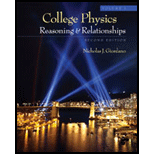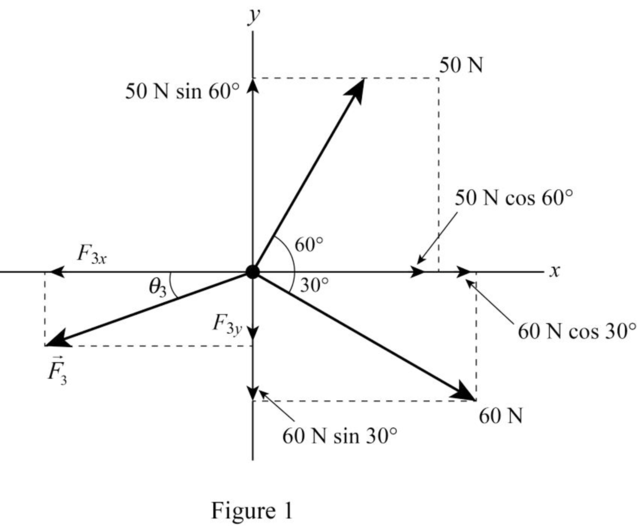
Concept explainers
The magnitude of force
Answer to Problem 2P
The magnitude of force
Explanation of Solution
The figure 1 shows the free body diagram for the particle and the x and y component of three forces

Write the expression for x component of the
Here,
Write the expression for y component of the
Here,
Write the expression for x component of the
Here,
Write the expression for y component of the
Here,
According to static equilibrium, the sum of the x component of the force acting on the particle is,
Here,
According to static equilibrium, the sum of the y component of the force acting on the particle is,
Here,
The net force
The angle acting on the force
Here,
Conclusion:
Substitute
Substitute
Substitute
Substitute
Substitute
Substitute
Substitute
Substitute
Therefore, the magnitude of force
Want to see more full solutions like this?
Chapter 4 Solutions
College Physics, Volume 1
- During a baseball game, a baseball is struck at ground level by a batter. The ball leaves the baseball bat with an initial speed v0 = 42 m/s at an angle θ = 43° above horizontal. Let the origin of the Cartesian coordinate system be the ball's position the instant it leaves the bat. Air resistance may be ignored throughout this problem. a.)Express the magnitude of the ball’s initial horizontal velocity v0x in terms of v0 and θ. b.)Express the magnitude of the ball’s initial vertical velocity v0y in terms of v0 and θ. c.)Find the ball’s maximum vertical height hmax in meters above the ground.arrow_forwardA car travels at 80 km/h on a level road in the positive direction of an x axis. Each tire has a diameter of 66 cm. Relative to a woman riding in the car and in unit-vector notation, what are the velocity at the (a) center, (b) top, and (c) bottom of the tire and the magnitude a of the acceleration at the (d) center, (e) top, and (f) bottom of each tire? Relative to a hitchhiker sitting next to the road and in unit-vector notation, what are the velocity at the (g) center, (h) top, and (i) bottom of the tire and the magnitude a of the acceleration at the (j) center, (k) top, and (l) bottom of each tire?arrow_forwardIrina, standing on the edge of a cliff, throws a stone at a 40-degree angle above the horizontal with an initial speed of 10.0 m/s. The instant before the stone hits the ground below, it is traveling at a speed of 63 m/s. If Irina were to throw the other rock at a 40-degree angle below the horizontal from the cliff instead, with the same initial speed of 10.0 m/s, what is the magnitude of the velocity of the stone just before it hits the ground? Ignore any effects of air resistancearrow_forward
- When you throw a ball through some trajectory (the angle above the horizontal is between O and 90 degrees) near the surface of the earth, which of the following vectors remain constant? Ignore air resistance. There may be more than one correct answer. a. horizontal velocity b. horizontal acceleration c. horizontal position d. vertical acceleration e. vertical position f. vertical velocityarrow_forwardIn the figure, a body with a mass of 2 kg moves under the influence of two constant forces F1 = 5N and F2 = 4N in the xy plane. At time t = 0, the object is at point 0 and its speed is V = 2i + j (m / s). What is the acceleration of the particle and its position after 2 seconds in terms of the unit vector?arrow_forwardA car travels at 80 km/h on a level road in the positive direction of an x axis. Each tire has a diameter of 66 cm. Relative to a woman riding in the car and in unit-vector notation, what are the velocity at the a) center, b) top, and c) bottom of the tire and the magnitude a of the acceleration at the d) center,arrow_forward
- Consider the motion of a bullet that is fired from a rifle 3 m above the ground in a northeast direction. The initial velocity of the bullet is150,150,0. Assume the x-axis points east, the y-axis points north, the positive z-axis is vertical (opposite g), the ground is horizontal, and only the gravitational force acts on the object. a. Find the velocity and position vectors for t≥0. b. Make a sketch of the trajectory. c. Determine the time of flight and range of the bullet. d. Determine the maximum height of the bullet.arrow_forwardA firefighter, a distance d from a burning building, directs a stream of water from a fire hose at angle i above the horizontal as shown in Figure P4.11. If the initial speed of the stream is vi, at what height h does the water strike the building? Figure P4.11arrow_forwardThe Vomit Comet. In microgravity astronaut training and equipment testing, NASA flies a KC135A aircraft along a parabolic flight path. As shown in Figure P3.45, the aircraft climbs from 24 000 ft to 31 000 ft, where it enters a parabolic path with a velocity of 143 m/s nose high at 45.0 and exits with velocity 143 m/s at 45.0 nose low. During this portion of the flight, the aircraft and objects inside its padded cabin are in free fall; astronauts and equipment float freely as if there were no gravity. What are the aircrafts (a) speed and (b) altitude at the top of the maneuver? (c) What is the time interval spent in microgravity?arrow_forward
- A student stands at the edge of a cliff and throws a stone horizontally over the edge with a speed of vi = 18.0 m/s. The cliff is h = 50.0 m above a body of water as shown in Figure P4.13. (a) What are the coordinates of the initial position of the stone? (b) What are the components of the initial velocity of the stone? (c) What is the appropriate analysis model for the vertical motion of the stone? (d) What is the appropriate analysis model for the horizontal motion of the stone? (e) Write symbolic equations for the x and y components of the velocity of the stone as a function of time. (f) Write symbolic equations for the position of the stone as a function of time. (g) How long after being released does the stone strike the water below the cliff? (h) With what speed and angle of impact does the stone land? Figure P4.13arrow_forward1. A golfer hits a golf ball on a flat, horizontal surface with an initial velocity of 67.7 m/s @ 45°. Calculate only (h) and (i): (a) Vox and Voy. (b) The time it will take the ball to reach maximum height. (c) The maximum height the ball will rise to. (d) The total air time of the ball. (e) The range of the ball. (f) The position (x,y) of the ball at t=1.0s. (g) The components of velocity of the ball (Vx, Vy) at 1.0s. (h) The velocity vector of the ball at 1.0s. (i) The velocity vector of the ball just as it hits the ground.arrow_forwardAn object of mass m1 = 4.00 kg is tied to an object of mass m2 = 3.00 kg with String 1 of length ℓ = 0.500 m. The combination is swung in a vertical circular path on a second string, String 2, of length ℓ = 0.500 m. During the motion, the two strings are collinear at all times as shown. At the top of its motion,m2 is traveling at υ = 4.00 m/s. (a) What is the tension in String 1 at this instant? (b) What is the tension in String 2 at this instant? (c) Which string will break first if the combination is rotated faster and faster?arrow_forward
 Principles of Physics: A Calculus-Based TextPhysicsISBN:9781133104261Author:Raymond A. Serway, John W. JewettPublisher:Cengage Learning
Principles of Physics: A Calculus-Based TextPhysicsISBN:9781133104261Author:Raymond A. Serway, John W. JewettPublisher:Cengage Learning Physics for Scientists and Engineers with Modern ...PhysicsISBN:9781337553292Author:Raymond A. Serway, John W. JewettPublisher:Cengage Learning
Physics for Scientists and Engineers with Modern ...PhysicsISBN:9781337553292Author:Raymond A. Serway, John W. JewettPublisher:Cengage Learning Physics for Scientists and EngineersPhysicsISBN:9781337553278Author:Raymond A. Serway, John W. JewettPublisher:Cengage Learning
Physics for Scientists and EngineersPhysicsISBN:9781337553278Author:Raymond A. Serway, John W. JewettPublisher:Cengage Learning


